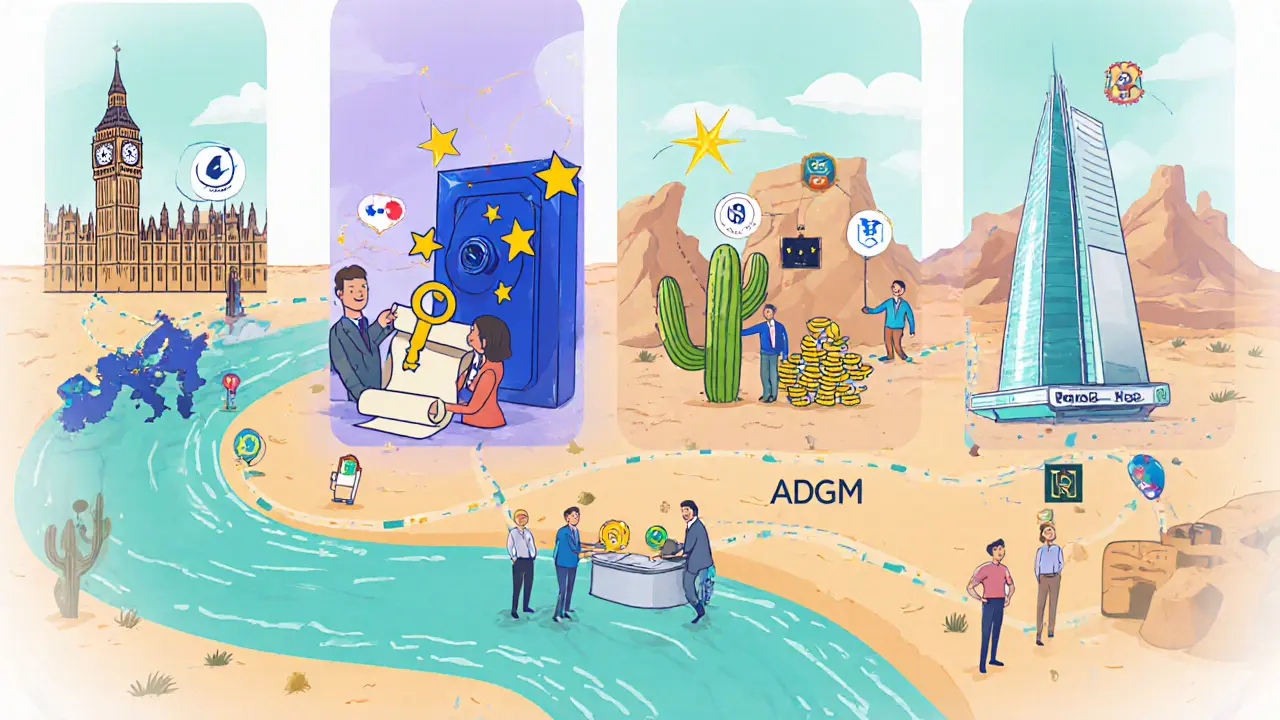Crypto Regulatory Sandbox Comparison Tool
Select a jurisdiction to compare key features of its regulatory sandbox program:
Selected Sandbox Details
Please select a jurisdiction to view details.
| Feature | UK (FCA) | EU (Blockchain Sandbox) | Arizona | ADGM |
|---|---|---|---|---|
| Administering Body | Financial Conduct Authority | European Commission | Arizona Department of Financial Institutions | ADGM RegLab |
| Focus Areas | Fintech & crypto tokens, AML/KYC | DLT projects, digital identity, smart contracts | Digital asset custody, payment tokens, DeFi | Tokenized assets, real estate, securities |
| Duration | 6-12 months | 12 months (renewable) | 9 months | 6-9 months |
| Graduation Path | FCA licence or EU passporting | Compliance with MiCA framework | State charter or federal licensing | Full ADGM securities licence |
Regulatory Sandbox Programs for Cryptocurrency are controlled testing zones where blockchain startups can trial new products under a relaxed set of rules while regulators keep a close eye on consumer safety. Imagine a playground where you can try out a new ride, but the park manager is there to stop you from hurting anyone. That’s exactly what these sandboxes aim to do for crypto innovators.
Quick Takeaways
- First sandbox launched by the Financial Conduct Authority (FCA) in the UK, 2015.
- The EU’s Blockchain Regulatory Sandbox accepts 20 projects a year, focusing on legal‑tech and consumer protection.
- Eight US states run their own programs; Arizona’s is now called the Financial Technology, Digital Assets and Blockchain Sandbox Program.
- Key benefits: faster product roll‑out, lower regulatory uncertainty, and direct feedback from regulators.
- Challenges include resource intensity, strict eligibility criteria, and the need for clear pathways to full compliance.
What Exactly Is a Crypto Regulatory Sandbox?
A sandbox is a legally defined “safe space” that grants temporary exemptions or flexible treatment of existing rules. Participants submit a proof‑of‑concept, agree to a limited testing window (often 6-12 months), and operate under a set of clear, regulator‑approved parameters. The regulator, in turn, monitors market impact, consumer protection outcomes, and gathers data to inform future policy.
Crucially, sandboxes are not a free‑for‑all. Companies must prove they have a viable business case, sufficient capital, and robust risk‑management procedures before they can even apply.
Global Landscape: Who’s Running Sandboxes?
The sandbox idea started in the United Kingdom, but today it’s a worldwide phenomenon.
- United Kingdom: The FCA’s sandbox, launched in 2015, was the first to allow fintech and crypto firms to test under a “regulatory waiver” model.
- European Union: The European Commission’s Blockchain Regulatory Sandbox (2023) provides legal advice rather than exemptions, focusing on digital identity, cybersecurity, AML/KYC, and smart‑contract liability.
- United States (State level): Arizona, Florida, Hawaii, Nevada, North Carolina, Utah, West Virginia, and Wyoming each run sandbox programs. Arizona’s 2024 rebrand explicitly mentions digital assets.
- Middle East: The Abu Dhabi Global Market (ADGM) operates RegLab, customizing supervision to each startup’s risk profile.
Each jurisdiction tailors its own focus-some stay narrow (e.g., AML‑only), while others, like the EU sandbox, tackle a full suite of regulatory topics.
How a Sandbox Works: Step‑by‑Step
- Eligibility screening: The regulator checks that the applicant is a legal entity registered for at least six months (EU rule) and that the project meets a maturity threshold.
- Application package: Companies submit a business plan, risk assessment, and technical architecture. For the EU sandbox, a legal‑tech panel reviews the submission.
- Testing agreement: Both parties sign a contract outlining the scope, duration, data‑share requirements, and consumer‑protection safeguards.
- Live pilot: The startup runs the product in a real‑world environment but under strict monitoring (transaction caps, user limits, etc.).
- Regulatory feedback: Regulators provide interim reports, suggest adjustments, and may issue interim guidance.
- Graduation or exit: Successful pilots receive a pathway to full licensing; unsuccessful ones must cease operations or re‑apply after redesign.
Throughout the process, the regulator may provide “regulatory sandboxes as a service” - offering advice on AML/KYC compliance, smart‑contract enforceability, or data‑privacy obligations.
Benefits for Startups and Regulators
From the startup side, the biggest win is speed. Instead of waiting months for a full license, companies can launch a limited beta and collect real‑world data. This reduces uncertainty and makes it easier to attract investors who see a lower regulatory risk.
For regulators, the sandbox is a learning laboratory. By observing how a new token model behaves under market conditions, they can fine‑tune rules before they become permanent. This co‑learning model has been praised by lawyers at JonesDay as "groundbreaking" because it flips the traditional top‑down approach.

Challenges and Pitfalls
Running a sandbox is resource‑heavy. Regulators need staff familiar with blockchain code, cryptography, and token economics. Startups must allocate legal counsel, compliance officers, and monitoring tools-often a significant budget for early‑stage companies.
Another risk is the “sandbox‑only” mindset: if a pilot succeeds inside the sandbox but the regulator later imposes stricter rules, the product may face a costly redesign. Clear graduation pathways, like the EU’s link to the upcoming Markets in Crypto‑Assets (MiCA) regulation, help mitigate this.
Success Stories
- FCA’s early crypto pilots: In 2018, a UK‑based stablecoin project used the FCA sandbox to test cross‑border payments, leading to the first regulator‑approved stablecoin framework in Europe.
- ADGM RegLab: The Dubai‑based sandbox helped a tokenized real‑estate platform iterate its smart‑contract logic, resulting in a full‑scale launch that now complies with UAE’s securities law.
- Arizona’s 2024 expansion: By explicitly including digital‑asset custody solutions, the state attracted three fintech firms that later secured national bank‑charter approvals.
Future Outlook: Toward Global Harmonisation
As more jurisdictions adopt sandbox frameworks, cross‑border coordination becomes essential. The EU’s sandbox already involves national regulators and a central EU panel, feeding insights directly into MiCA. In the US, there is growing talk of a federal “sandbox coalition” to align state‑level rules.
Long‑term forecasts suggest sandboxes will evolve from short‑term pilots to permanent “innovation hubs” embedded within regulatory bodies. This shift would give crypto firms a predictable route to market while preserving consumer safeguards.
Checklist for Crypto Startups Considering a Sandbox
- Confirm legal entity status (registered >6months in the target jurisdiction).
- Prepare a concise business case with clear problem/solution fit.
- Develop a risk‑assessment matrix covering AML/KYC, cybersecurity, and smart‑contract liability.
- Identify a regulator‑friendly partner (legal counsel experienced in fintech).
- Map out a graduation plan: how you’ll transition from sandbox to full licensing.
- Allocate budget for compliance staff and monitoring tools (average cost: 5‑10% of seed capital).
Comparison of Leading Crypto Sandbox Programs
| Jurisdiction | Administering Body | Scope | Typical Duration | Graduation Path |
|---|---|---|---|---|
| United Kingdom | Financial Conduct Authority (FCA) | Fintech & crypto tokens, AML/KYC focus | 6‑12 months | FCA licence or EU passporting |
| European Union | European Commission - Blockchain Sandbox | DLT projects, digital identity, smart contracts, consumer protection | 12 months (renewable) | Compliance with MiCA framework |
| Arizona, USA | Arizona Department of Financial Institutions | Digital‑asset custody, payment tokens, DeFi services | 9 months | State charter or federal licensing |
| Abu Dhabi Global Market (ADGM) | ADGM RegLab | Tokenized assets, real‑estate, securities‑token offerings | 6‑9 months | Full ADGM securities licence |
Next Steps for Readers
If you’re a founder, start by mapping your product to the sandbox most aligned with your use case. Reach out to the regulator’s innovation desk - they usually have a point of contact for sandbox enquiries. If you’re a regulator, consider establishing a dedicated blockchain advisory panel; the EU’s model shows how expert input shortens policy cycles.

Frequently Asked Questions
What types of crypto projects can join a sandbox?
Most sandboxes accept projects that have a working prototype, clear consumer‑impact assessment, and a plan to address AML/KYC. Typical categories include stablecoins, tokenized assets, decentralized finance platforms, and blockchain‑based identity solutions.
How long does a sandbox trial usually last?
Durations vary by jurisdiction but most range from six to twelve months. Some programs, like the EU sandbox, allow extensions if milestones are met.
Do sandbox participants have to pay fees?
Many regulators charge a modest application fee (often $1,000‑$5,000) to cover administrative costs. Some jurisdictions waive fees for early‑stage startups.
What happens after the sandbox ends?
Successful pilots receive a clear path to full licensing or chartering. If the pilot does not meet regulatory standards, the company must either adjust the product or discontinue the service.
Can sandbox insights influence future regulations?
Yes. Data collected during sandbox trials often feeds directly into policy drafts. The EU sandbox, for example, contributed to the shaping of the MiCA regulation.


Comments
Jason Brittin
Looking at these sandbox programs feels like watching a sandbox playground where the kids actually have fire alarms on. 🤷♂️ Still, the speed they give startups is pretty sweet.
November 27, 2024 AT 01:23
Amie Wilensky
When one reads the sandbox overview, one cannot help but notice the juxtaposition of legal rigor-, the promise of speed, and the ever‑present shadow of regulatory uncertainty; it is, frankly, a paradox wrapped in a compliance checklist,; yet the data speaks for itself.
December 2, 2024 AT 20:16
MD Razu
The concept of a regulatory sandbox, at its core, is an experiment in co‑governance between innovators and authorities. It acknowledges that traditional rulebooks were drafted for legacy finance, not for code that settles in seconds. By granting a temporary exemption, regulators can observe real‑world risk without exposing the entire market to unchecked speculation. The FCA’s early sandbox, for instance, allowed a stablecoin project to test cross‑border payments under a controlled cap, which later informed Europe’s MiCA drafts. In the EU, the Blockchain Sandbox opts for legal advice rather than outright waivers, a subtle but significant shift toward prescriptive guidance. Arizona’s program explicitly includes custody solutions, reflecting the state’s pragmatic approach to attract fintech firms seeking charter pathways. ADGM’s RegLab, meanwhile, tailors supervision to each startup’s risk profile, a model that could inspire tiered oversight globally. One of the most compelling benefits is the data feedback loop: regulators collect transaction metrics, AML alerts, and consumer complaints in near real time. Startups, on the other hand, receive rapid clarification on compliance expectations, reducing the months‑long limbo that typically follows a license application. This symbiosis, however, is not without friction; the resource burden on regulators to staff blockchain‑savvy analysts remains a critical bottleneck. Moreover, the “sandbox‑only” mindset can create a false sense of security if the pilot’s success is later undermined by stricter post‑sandbox regulations. Therefore, a transparent graduation pathway-such as linking the EU sandbox outcomes to MiCA compliance-is essential for preserving investor confidence. From a financial perspective, the cost of running a sandbox (often a few hundred thousand dollars) can be justified by the downstream economic activity it unlocks. Critics argue that the limited number of slots (e.g., 20 projects per year in the EU) may favor well‑connected firms over true innovators. Yet the iterative nature of these programs encourages continuous refinement, which could eventually lower entry barriers for the next wave of crypto ventures. In conclusion, sandbox programs act as living laboratories, nudging the industry toward responsible innovation while giving regulators a pragmatic view of emerging technology.
December 8, 2024 AT 15:09
Charles Banks Jr.
Oh great, another sandbox, because what the crypto world really needed was more paperwork. At least they finally realized you can’t just launch a token and hope for the best. Yeah, let’s see how many months of “fast‑track” actually turn into a full licence.
December 14, 2024 AT 10:03
Ben Dwyer
Good overview, thanks for the clarity.
December 20, 2024 AT 04:56
Lindsay Miller
I feel you on the paperwork thing-sometimes it looks like you need a PhD in law just to file an application. The sandbox concept is solid, but the execution can feel like a treadmill. Keep pushing, the payoff is worth it.
December 25, 2024 AT 23:49
Katrinka Scribner
Wow, that was a lot of info!! 😂 I love how the EU actually gives legal advice instead of just waving a magic wand. It feels more real, you know? Even if I typo a lot, the excitement is real!
December 31, 2024 AT 18:43
VICKIE MALBRUE
Sandboxes are a bright spot for crypto innovation - keep the momentum going!
January 6, 2025 AT 13:36
Waynne Kilian
Totally agree! Seeing more jurisdictions open up feels like a global hug for builders.
January 12, 2025 AT 08:29
Naomi Snelling
All this talk about sandboxes is just a smokescreen. They're a way for regulators to keep tighter control while pretending to be helpful. Nobody's really winning here.
January 18, 2025 AT 03:23
Michael Wilkinson
Look, if you think sandboxes are a trap, you’re missing the fact that real data is being collected and that’s the only way we move forward. Stop whining.
January 23, 2025 AT 22:16
Billy Krzemien
This breakdown makes it easier for founders to decide where to apply. The clear graduation paths are especially helpful.
January 29, 2025 AT 17:09
april harper
Well, the article is thorough, but let’s be honest – many of these programs are just vanity projects for regulators to claim they’re "innovative".
February 4, 2025 AT 12:03
Clint Barnett
Reading through the comparison really highlights how each jurisdiction tailors its sandbox to its own ecosystem strengths. The UK leans heavily on AML/KYC, which makes sense given its legacy financial hub status, while the EU’s focus on digital identity aligns with broader regulatory ambitions around data sovereignty. Arizona’s explicit inclusion of custody services shows a pragmatic approach to attract fintech firms that need a clear path to chartering, and ADGM’s bespoke supervision model is a clever way to balance innovation with investor protection. It’s fascinating to see how the duration lengths vary – shorter cycles can accelerate time‑to‑market but may also limit depth of testing, whereas longer programs give startups room to iterate. The graduation pathways are equally important; without a transparent route to a full licence, a sandbox can become a dead‑end. Overall, these programs demonstrate that a one‑size‑fits‑all model simply won’t work in the fast‑moving crypto space.
February 10, 2025 AT 06:56
Jacob Anderson
Nice summary, but if you’re still surprised that sandboxes exist, maybe you should have read the news a decade ago.
February 16, 2025 AT 01:49
Kate Nicholls
The article does a solid job of laying out the facts without getting bogged down in hype.
February 21, 2025 AT 20:43
Carl Robertson
Finally, something that actually talks about the messy reality of regulation. Too bad most people will just skim and miss the nuance.
February 27, 2025 AT 15:36
Rajini N
If you’re looking to join a sandbox, start by aligning your product with the jurisdiction’s focus area – it saves a lot of back‑and‑forth with the regulator.
March 5, 2025 AT 10:29
Sidharth Praveen
Great read! It’s exciting to see more pathways for crypto innovation.
March 11, 2025 AT 05:23
Sophie Sturdevant
The sandbox ecosystem is a complex matrix of compliance frameworks, risk‑assessment protocols, and jurisdiction‑specific licensing pathways that demand a high‑frequency, low‑latency operational model for successful navigation.
March 17, 2025 AT 00:16
Nathan Blades
Wow, this really pumps me up! 🎉 Seeing all these sandbox options gives founders the confidence to experiment boldly.
March 22, 2025 AT 19:09
Somesh Nikam
Thanks for the breakdown – got some ideas for my next project! 😊
March 28, 2025 AT 14:03